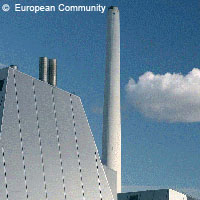Towards zero emissions from fossil fuels
A new document outlines the possibilities for reaching zero emissions from power stations fed by fossil fuels - coal, oil and natural gas. While these resources are for the moment abundant, they are significant polluters of the environment, and one of the most significant contributors of carbon dioxide (CO2) emissions, which contributes to global warming. The new 'vision document', outlines the hopes of the European Technology Platform for Zero Emission Fossil Fuel Power Plants (ZEP). ZEP will examine a wide area of research into carbon capture and storage (CCS), from carbon sequestration to 'cracking' fossil fuels to release their hydrogen - a genuinely emission-less fuel. While environmental concerns are very high on the agenda in Europe, so too are energy concerns. Since the Russian falling out with Ukraine in winter 2005-2006, when Russia turned off the natural gas supply, and also on account of the ever-increasing price of oil, energy has shot to the top of the European, and worldwide, agenda. The document outlines the EU's energy priorities, which are balanced between supply and environmental concern: - ensuring the security of a sustainable energy supply; - achieving sharp reductions in CO2 emissions from fossil fuel power plants; - maintaining EU industrial competitiveness, for the global market, developing active reductions in carbon emissions. 'Through co-operative RTD [research and technological development] actions, both within and outside of the Union, Europe is creating a critical mass of expertise, ideas and solutions strengthening European excellence. The setting up of this Technology Platform for 'Zero Emission Fossil Fuel Power Generation' is one essential way of responding to these ambitious objectives,' says EU Commissioner for Science and Research Janez Potocnik in the pamphlet's introduction. ZEP will seek to address the most pertinent ways to reduce CO2 emissions, firstly through increasing the efficiency of power stations, using low-carbon fuels, developing CO2 'sinks' (such as planting forests and preventing their burning or using special CO2 absorbing soils), using renewables and CO2 neutral fuels, and capturing and storing CO2. Diversifying Europe's fuel sources cannot happen overnight, and for the moment, we have to stick to fossil fuels for the bulk of our energy needs, but we can also try to mitigate the effects of fossil fuels - by capturing CO2 emissions and improving the efficiency of plants. This leaves us with three options, which ZEP is designed to address: Post-combustion capture, where CO2 is captured, usually by chemical means, and then disposed of. What then to do with the CO2 is open to question. Sequestration will most likely take place underground, possibly in the vast caverns left from oil drilling. The network of reservoirs in the North Sea already provides a possible candidate, as do saline aquifers and non-minable coal seams. Pre-combustion capture is where the fuel reacts with air or steam to produce a combination of carbon monoxide (CO) and hydrogen. The resulting mixture can be purified to remove the CO, leaving hydrogen, which reacts with oxygen to produce water. Oxy-fuel firing, where the fossil fuel is burnt in pure oxygen, gives a gas of mostly water and CO2. Because water can be condensed easily, it can be removed easily, leaving CO2 for disposal The techniques developed under ZEP will be of crucial importance in the future, as the pressure for cleaner fuels will be paramount. ZEP will also investigate the best ways to transport and store or inject CO2 into geological formations and how safe these processes are.



